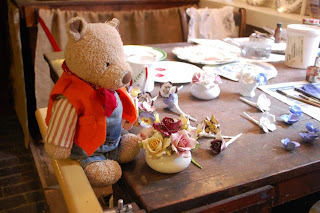Last month, Grizzly's cousin from New Zealand came to stay with us for a few days. One of the places we visited with him was the Gladstone Pottery Museum in Longton.
It is the only traditional 'potbank' to have been saved with all its bottle-kilns and is one of the places Polar and Grizzly like to take visitors, so they can learn about the history of Stoke-on-Trent.
There are plenty of exciting things for small bears to do. We bounced in the baskets which used to be used for transporting crockery, then we climbed up a big pile of 'saggers'. These are earthenware containers into which cups, plates and other items were carefully placed before they were taken to the bottle kilns for firing.
The kiln for firing the pottery is inside the bottle-shaped building, which protects it from the weather and helps it to get really hot. All around the outside were the fire boxes, where the coal went in.
Firing the kilns would have been very hot work and definitely not for small bears or anyone else with fur!
Somewhere else that would have been too hot for furry friends was the blacksmith's forge, where any tools or metal things needed about the potbank were made, which was in the engine room.
The engine is now run by electricity, so you can see how it powered a mass of cogs and wheels, which worked a series of strange machines with funny names to clean and mix the clay.
Hanley Bear found a diagram of how it worked so he could explain all the different stages of processing the clay to us. Then he showed us photographs of some of the pottery workers, including some who were just human cubs. We read about the hard lives they had and felt very sad for them.
Across the yard was the workshop where the saggers were made. A team of workers put them together, including the sagger-maker's bottom-knocker, whose job involved using a heavy mallet to flatten clay inside a metal hoop, to shape the base of the sagger.
We decided that would not been a job which small bears could do, as we couldn't have lifted the mallet, although a lot of small bears working together might have been able to trample the clay to make a sagger bottom. However, they would have needed boots to keep their back paws and claws clean and clay out of their fur.
After that, we went to see a pot being 'thrown' on a wheel. Hanley Bear watched closely.
'Can I have a go?' he asked.
But the lady explained that he would need a much smaller wheel as if he stood where he could reach the pot, he would be on the wheel with it, whizzing round and round!
In the next room, a lady was making shapes by pouring liquid clay - called 'slip' into plaster-of-Paris moulds. After a few minutes, the slip is poured out again, but a layer is left inside the mould. When it dries, it shrinks away from the sides of the mould which is then opened carefully and the shape is taken out to finish drying before being fired.
While Hanley and Endon watched the slip casting, I went to see the lady making china flowers. At last, I had found a job that small bears could do! We would need to practice for a very long time to make such pretty, neat flowers as the ladies make at Gladstone, but at least it is not a hot or heavy job.
We definitely couldn't have loaded or unloaded the kilns. The next one we visited was stacked high with saggers. Hanley Bear went right inside to explore.
'If you were a bigger bear, this would have been a good job for you, Endon,' he said to our little friend. 'You could use your climbing skills to go right up the ladders to put the saggers in place at the very top!'
Endon said he wouldn't have minded putting things in when the kiln was cool but he wouldn't have gone in to take everything out again when it was still hot inside, like some bad employers made their workers do. 'I would have growled at them!' he said.
'I've found a much nicer job for small bears!' I said. 'There's a workshop here where a lady is painting the china flowers, and it smells really nice too.'
The smell was from the natural oils used to mix the paint pigments. The paintress was using turpentine, distilled from pine trees, so the room smelled like being deep in the woods. She let me watch while she painted some pretty pansies in a little pot. I would have liked to try some painting myself, but Polar and Grizzly said we had more of the museum to explore.
'We hope it all smells as nice as this room,' I said, as we got back into our bear bag to be carried up some metal stairs.
But, as you will find out next time, it didn't!





































No comments:
Post a Comment